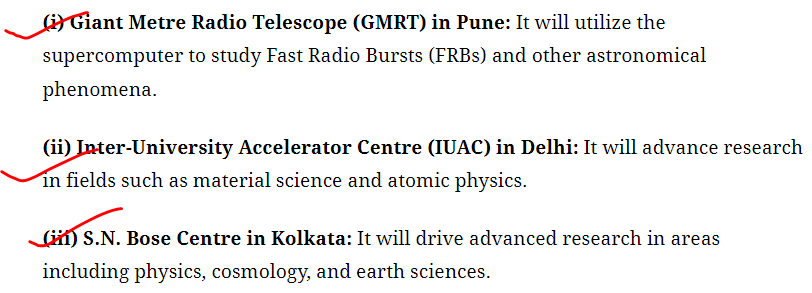PARAM Rudra Supercomputers
Current Affair 1:
News:

Three new supercomputers, installed at premier scientific institutions in Delhi, Pune and Kolkata, to boost research in the fields of astronomy, medicine and high-energy physics.
The three new supercomputers are all indigenously-built PARAM Rudra computers, developed under the National Supercomputing Mission.
One of them has been installed at Giant Metrewave Radio Telescope (GMRT) near Pune, which is one of the world’s largest and most powerful radio telescopes in the meter-wave range. The other two have been set up in Delhi-based Inter-University Accelerator Centre (IUAC), and the S N Bose National Centre for Basic Sciences in Kolkata.
What are HPC (High-Performance Computing) Supercomputing Systems?
HPC (High-Performance Computing) Supercomputing Systems are advanced computing environments designed to handle complex and data-intensive tasks that require significant computational power. HPC systems leverage the processing capabilities of multiple processors working in parallel to solve large-scale problems.
Param Rudra is a high-performance computing system designed to handle complex calculations and simulations at remarkable speeds. These supercomputers are the result of India's National Supercomputing Mission (NSM), showcasing the country's growing capabilities in developing advanced technologies domestically.
Supercomputers have been deployed in Pune, Delhi, and Kolkata to support groundbreaking scientific research:

The most powerful of these is the one installed at IUAC which has 3 petaflop capacity. GMRT has got one petaflop supercomputer, while the one at S N Bose institute has a capacity of 838 terraflops.
In addition to the Param Rudra systems, PM Modi also introduced two High-Performance Computing (HPC) systems named Arka and Arunika, specifically designed for weather and climate research. With a combined investment of Rs 850 crore, these systems aim to significantly improve India's weather forecasting capabilities.
|
Arka system at IITM has a 11.77 Peta Flop capacity and will, for the first time, help improve the country’s horizontal resolution of its global weather prediction models to 6 km from the existing 12 km. HPC Arunika comes with a 8.24 Peta Flop capacity. This HPC will prove beneficial in upgrading weather forecast resolution at block levels. |
They will enhance India's computational capabilities, positioning the country as a global leader in supercomputing.
FLOPs in Computing
FLOPs, or Floating-Point Operations per Second, is a commonly used metric to measure the computational performance – processing power and efficiency – especially in the field of high-performance computing (HPC) and artificial intelligence (AI). Floating-point operations are a certain kind of mathematical calculation using real numbers with fractional parts.
FLOPs is not the only factor determining the performance of a computing system. Memory bandwidth, latency, and other architectural features also play significant roles.
petaFLOP
Due to the immense computing power of today’s computers, the FLOPs metric is most often represented in terms of billions (giga), trillions (tera), or even quadrillions (peta) of operations per second (GFLOPs, TFLOPs, PFLOPs, respectively). A petaflop is thus equal to a thousand TFLOPs or 1015 FLOPs.
About National Supercomputing Mission:
The National Supercomputing Mission (NSM) was launched in 2015 to connect national academic and research and development institutions with a grid of high-performance computing facilities.
NSM is jointly managed by the Department of Science and Technology (DST) and the Ministry of Electronics and IT (MeitY). It is implemented by the Centre for Development of Advanced Computing (C-DAC) in Pune and the Indian Institute of Science (IISc) in Bengaluru.
The mission aims at creating a powerful supercomputing capability for the country and offer powerful computational facilities to boost research.
The main objectives of the mission are:
- Make India a world leader in HPC and to enhance the national capability in solving grand challenge problems of national and global relevance.
- Empower scientists & researchers with state-of-the-art compute facilities for their cutting-edge research in respective Domains.
- Reduce redundancies and avoid duplication of efforts and investments
- Create an ecosystem for positioning India as a major power for supercomputing and attain global competitiveness and self-reliance in HPC



